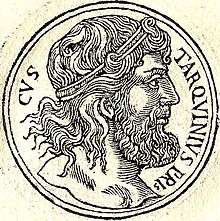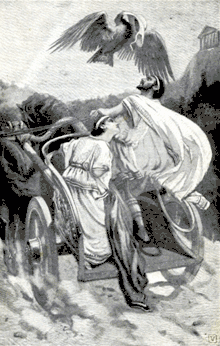Lucius Tarquinius Priscus
Lucius Tarquinius Priscus, or Tarquin the Elder, was the legendary fifth king of Rome from 616 to 579 BC. His wife was Tanaquil.
| Lucius Tarquinius Priscus | |
|---|---|
 Lucius Tarquinius Priscus, 16th-century depiction published by Guillaume Rouillé | |
| King of Rome | |
| Reign | 616–579 BC |
| Predecessor | Ancus Marcius |
| Successor | Servius Tullius |
| Father | Demaratus of Corinth |
Early life
According to Livy, Tarquin came from Etruria. Livy claims that his original Etruscan name was Lucumo, but since lucumo (Etruscan Lauchume) is the Etruscan word for "king", there is reason to believe that Priscus' name and title have been confused in the official tradition. After inheriting his father's entire fortune, Lucius attempted to gain a political office. Disgruntled with his opportunities in Etruria (he had been prohibited from obtaining political office in Tarquinii because of the ethnicity of his father, Demaratus, who came from the Greek city of Corinth), he migrated to Rome with his wife Tanaquil, at her suggestion. Legend has it that on his arrival in Rome in a chariot, an eagle took his cap, flew away and then returned it back upon his head. Tanaquil, who was skilled in prophecy, interpreted this as an omen of his future greatness. In Rome, he attained respect through his courtesy. The king himself noticed Tarquinius and, by his will, appointed Tarquinius guardian of his own sons.[1]
King of Rome

Although Ancus Marcius, the Roman king, was the grandson of Numa Pompilius, the second King of Rome, the principle of hereditary monarchy was not yet established at Rome; none of the first three kings had been succeeded by their sons, and each subsequent king had been acclaimed by the people. Upon the death of Marcius, Tarquin addressed the Comitia Curiata and convinced them that he should be elected king over Marcius' natural sons, who were still only youths. In one tradition, the sons were away on a hunting expedition at the time of their father's death, and were thus unable to affect the assembly's choice.[2]
According to Livy, Tarquin increased the number of the Senate by adding one hundred men from the leading minor families.[2] Among these was the family of the Octavii, from whom the first emperor, Augustus, was descended.[3]
Tarquin's first war was waged against the Latins. Tarquinius took the Latin town of Apiolae by storm and took great booty from there back to Rome.[2] According to the Fasti Triumphales, this war must have occurred prior to 588 BC.
His military ability was then tested by an attack from the Sabines, who received auxiliaries from five Etruscan cities. Tarquin doubled the numbers of equites to help the war effort.[1] The Sabines were defeated after difficult street fighting in the city of Rome.[4] In the peace negotiations that followed, Tarquin received the town of Collatia, and appointed his nephew, Arruns Tarquinius, better known as Egerius, as commander of the garrison there. Tarquin returned to Rome and celebrated a triumph on September 13, 585 BC.[5]
Subsequently, the Latin cities of Corniculum, old Ficulea, Cameria, Crustumerium, Ameriola, Medullia, and Nomentum were subdued and became Roman.[6]
Since Tarquin had kept the captured Etruscan auxiliaries prisoners for meddling in the war with the Sabines, the five Etruscan cities who had taken part declared war on Rome. Seven other Etruscan cities joined forces with them. The Etruscans soon captured the Roman colony at Fidenae, which thereupon became the focal point of the war. After several bloody battles, Tarquin was once again victorious, and he subjugated the Etruscan cities who had taken part in the war. At the successful conclusion of each of his wars, Rome was enriched by Tarquin's plunder.
Tarquin is said to have built the Circus Maximus, the first and largest stadium at Rome, for chariot racing. Raised seating was erected privately by the senators and equites, and other areas were marked out for private citizens. There the king established a series of annual games; according to Livy, the first horses and boxers to participate were brought from Etruria.[2]
After a great flood, Tarquin drained the damp lowlands of Rome by constructing the Cloaca Maxima, Rome's great sewer. He also constructed a stone wall around the city, and began the construction of a temple in honour of Jupiter Optimus Maximus on the Capitoline Hill. The latter is said to have been funded in part by the plunder seized from the Sabines.[6]
According to Florus, Tarquin celebrated his triumphs in the Etruscan fashion, riding a golden chariot drawn by four horses, while wearing a gold-embroidered toga and the tunica palmata, a tunic upon which palm-leaves were embroidered. He also introduced other Etruscan insignia of civilian authority and military distinction: the sceptre of the king; the trabea, a purple garment that varied in form, but was perhaps most often used as a mantle; the fasces carried by the lictors; the curule chair; the toga praetexta, later worn by various magistrates and officials; the rings worn by senators; the paludamentum, a cloak associated with military command; and the phalera, a disc of metal worn on a soldier's breastplate during parades, or displayed on the standards of various military units.[7] Strabo reports that Tarquin introduced Etruscan sacrificial and divinitory rites, as well as the tuba, a straight horn used chiefly for military purposes.[8] [9]
Death and succession
Tarquin is said to have reigned for thirty-eight years. According to legend, the sons of his predecessor, Ancus Marcius, believed that the throne should have been theirs. They arranged the king's assassination, disguised as a riot, during which Tarquin received a fatal blow to the head. However, the queen, Tanaquil, gave out that the king was merely wounded, and took advantage of the confusion to establish Servius Tullius as regent; when the death of Tarquin was confirmed, Tullius became king, in place of Marcius' sons, or those of Tarquin.
Tullius, said to have been the son of Servius Tullius, a prince of Corniculum who had fallen in battle against Tarquin, was brought to the palace as a child with his mother, Ocreisia. According to legend, Tanaquil discovered his potential for greatness by means of various omens, and therefore preferred him to her own sons. Tullius married Tarquinia, one of Priscus daughters, thus providing a vital link between the families. Tullius' own daughters were subsequently married to the king's sons (or, in some traditions, grandsons), Lucius and Arruns.
Most ancient writers regarded Tarquin as the father of Lucius Tarquinius Superbus, the seventh and last King of Rome, but some stated that the younger Tarquin was his grandson. As the younger Tarquin died about 496 BC, more than eighty years after Tarquinius Priscus, chronology seems to support the latter tradition. An Etruscan legend related by the emperor Claudius equates Servius Tullius with Macstarna (apparently the Etruscan equivalent of the Latin magister), a companion of the Etruscan heroes Aulus and Caelius Vibenna, who helped free the brothers from captivity, slaying their captors, including a Roman named Gnaeus Tarquinius. This episode is depicted in a fresco at the tomb of the Etruscan Saties family at Vulci, now known as the François Tomb. This tradition suggests that perhaps the sons of the elder Tarquin attempted to seize power, but were defeated by the regent, Servius Tullius, and his companions; Tullius would then have attempted to end the dynastic struggle by marrying his daughters to the grandsons of Tarquinius Priscus. However, this plan ultimately failed, as Tullius was himself assassinated at the instigation of his son-in-law, who succeeded him.
Notes
- Livy, Ab urbe condita, 1:34
- Livy, Ab urbe condita, 1:35
- Suetonius, The Life of Augustus 2.
- Eutropius, Breviarium historiae romanae, I, 6.
- Fasti Triumphales
- Livy, Ab urbe condita, 1:38
- Florus, Epitoma de Tito Livio bellorum omnium annorum DCC, I, 5.6.
- Strabo, Geographia, V, 2.2
-

References
External links
- Stemma Tarquiniorum, Tarquinius family tree
| Legendary titles | ||
|---|---|---|
| Preceded by Ancus Marcius |
King of Rome 616–579 |
Succeeded by Servius Tullius |

